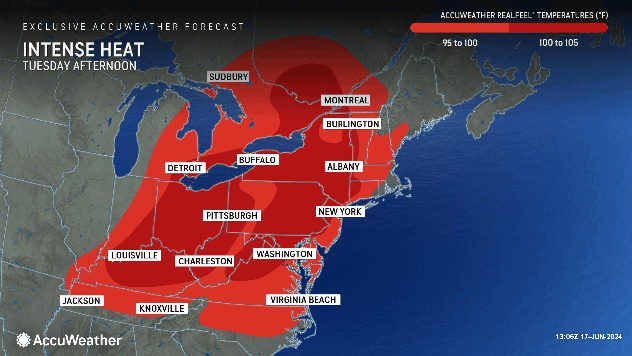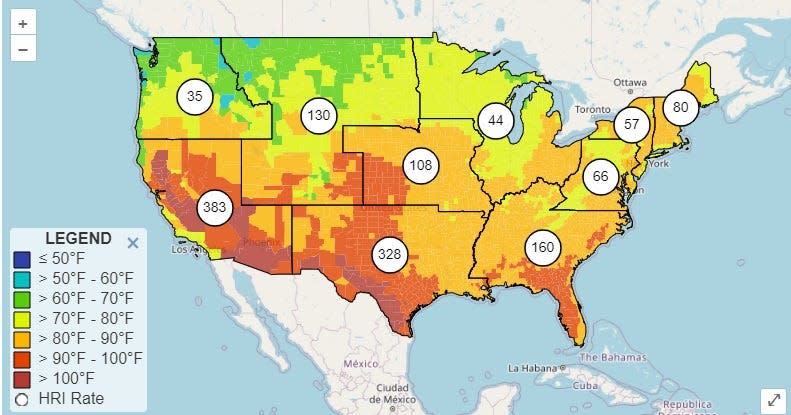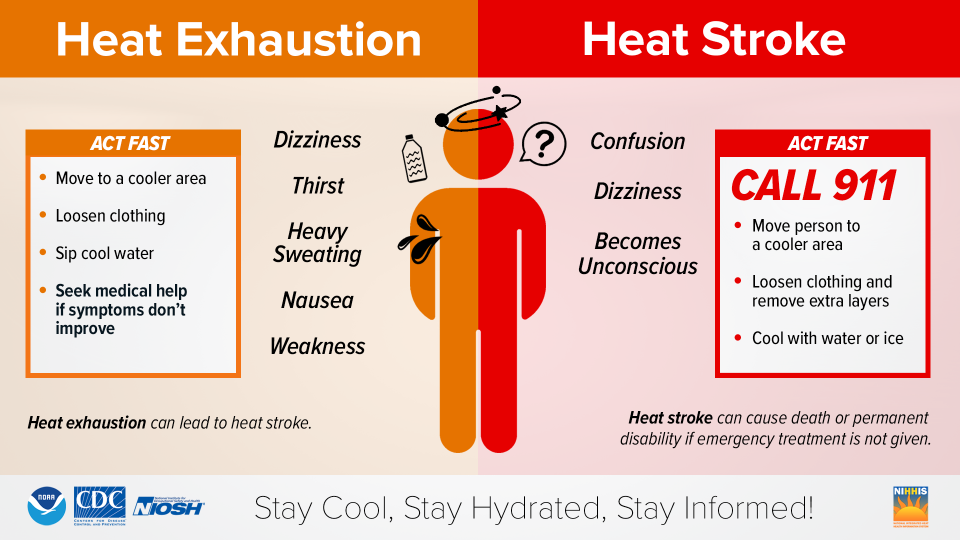Heat dome? Heat wave? How hot is it getting? Here's what you should know
Temperatures across the Midwest and Northeast are expected to be the hottest in years, with temps near or at 100 in several cities.
Temps in the 90s aren't that unusual in Florida, after adding the heat index and associated humidity, we often experience "feels-like" temps well into triple digits.
And while millions across the U.S. will be suffering the effects of this week's heat wave, Florida temps are actually a bit on the "cooler" side, topping out — usually — below 90.
That won't last, though. Depending on where you live in the Sunshine State, temperatures will start inching their way back up to 90 and above by next week, with the exception of South and Southwest Florida, which may continue to enjoy temps in the mid to upper 80s.
Here's what you should know about the heat and what's coming.
Heat wave driving up temperatures in US Midwest, Northeast

For many in the Midwest and Northeast, this week will be the first official heat wave of the season, which, in this part of the country is defined as three or more consecutive days of at least 90-degree temperatures, according to AccuWeather.
Heat alerts have been issued for more than a dozen states, stretching from Iowa and Illinois to Maine.
High temperatures will be in the 90s for a week or more in major metro areas such as Chicago, Detroit, Pittsburgh, Washington, D.C., Baltimore and Philadelphia, according to AccuWeather, challenging daily record highs, with a couple dating back to the 1920s and 1930s,
Many locations will be within a few degrees of triple digits, with a few spots predicted to reach 100 degrees.
See weather-related watches, warnings, advisories across Florida, US
Forecast high temperatures across the US Midwest, Northeast
High temperatures expected for several Midwest and Northeast cities Juneteenth and June 20. Watch as temperatures drop between this week and early next week:
Manchester, New Hampshire: 97, 99. Dropping to 86 by June 24.
Albany, New York: 96, 97. Dropping to 86 by June 24.
Detroit, Michigan: 95, 93. Dropping to 83 by June 24.
Toledo, Ohio: 94, 96. Dropping to 84 by June 24.
Indianapolis, Indiana: 92, 95. Jumping to 96 by Saturday, June 22 before dropping to 97 on June 24.
Caribou, Maine: 96, 95. Dropping to 76 by June 24.
Philadelphia, Pennsylvania: 94, 95. Jumping to 100 by Friday, June 21 before dropping to 90 on June 24.
Boston, Massachusetts: 95, 97. Dropping to 85 by June 24.
Washington, D.C.: 90, 92. Jumping to 98 by Saturday June 22 before dropping slightly to 93 on June 24.
Setting your a/c thermostat: Florida high heat index: What's the best temperature to set your air conditioner thermostat?
Compare US temps with those in Florida as June winds to close
High temperatures expected around Florida show less variation between this week and early next week, except for Jacksonville, which could see a 10-degree jump between Wednesday and Monday. Naples stands out with a predicted drop of 3 degrees over the same period.
Pensacola: 89, 89. On June 24, 90.
Tallahassee: 93, 93. On June 24, 97.
Jacksonville: 87, 86. On June 24, 97.
Daytona Beach: 85, 84. On June 24, 90.
Melbourne: 87, 87. On June 24, 90.
Port St. Lucie: 87, 87. On June 24, 89.
West Palm Beach: 84, 84. On June 24, 85.
Naples: 91, 91. On June 24, 88.
Fort Myers: 91, 92. On June 24, 90.
Sarasota: 89, 91. On June 24, 88.
What is a 'heat dome'?
The phrase "heat dome" really isn't a scientific term, according to Jessie Schaper, meteorologist with the National Weather Service Melbourne.
Where confusion comes may be what's happening in the atmosphere.
"Under high pressure, the air subsides — sinks — toward the surface. This sinking air acts as a dome capping the atmosphere, NOAA said.
"This cap helps to trap heat instead of allowing it to lift. Without lift, there is little or no convection and, therefore, little or no convective clouds — cumulus clouds — with minimal chances for rain. The end result is a continual build-up of heat at the surface that we experience as a heat wave."
A heat wave is a period of abnormally hot weather generally lasting more than two days, according to the National Weather Service.
CDC maps heat-related illnesses by state, county

The Heat-Related Illness and Temperature map issued by the Centers for Disease Control shows the rate of emergency department visits associated with heat-related illness per 100,000 emergency visits by region.
➤ Interactive map: See daily and weekly illnesses
What is a heat advisory?
A heat advisory is one of several types of health alerts issued by the National Weather Service. A heat advisory is issued within 12 hours of the onset of extremely dangerous heat conditions.
In Florida, except for Miami-Dade County, the National Weather Services offices around the state would issue a heat advisory if the heat index is expected to reach 108 to 112 degrees. The National Weather Service Miami said Miami/Dade County wanted a lower threshold for an advisory for its population, which was set at 105 degrees.
If a heat advisory is issued, take precautions to avoid heat illness. If you don't take precautions, you may become seriously ill or even die.
What types of heat warnings does NWS issue?
The National Weather Service issues several types of heat-related advisories, including:
Excessive heat warning: An excessive heat warning is issued within 12 hours of the onset of extremely dangerous heat conditions. If you don't take precautions immediately when conditions are extreme, you may become seriously ill or even die.
Excessive heat watch: Heat watches are issued when conditions are favorable for an excessive heat event in the next 24 to 72 hours. A watch is used when the risk of a heat wave has increased but its occurrence and timing is still uncertain.
Excessive heat outlooks: The outlooks are issued when the potential exists for an excessive heat event in the next three to seven days. An outlook provides information to those who need considerable time to prepare for the event.
Heat stroke vs heat exhaustion: How to tell the difference

When your body can't cool itself, your body temperature rises. If it goes too high, it can be life-threatening.
The Centers for Disease Control and Prevention provided a list of warning signs and symptoms of heat-related illnessesand what you should do.
Heat cramps
Heat cramps may be the first sign of heat-related illness, and may lead to heat exhaustion or stroke.
Symptoms: Painful muscle cramps and spasms usually in legs and abdomen and heavy sweating.
First aid: Apply firm pressure on cramping muscles or gently massage to relieve spasm. Give sips of water unless the person complains of nausea, then stop giving water.
Seek immediate medical attention if cramps last longer than 1 hour.
Heat exhaustion
Symptoms: Heavy sweating, Weakness or tiredness, cool, pale, clammy skin; fast, weak pulse, muscle cramps, dizziness, nausea or vomiting, headache, fainting,
First aid: Move person to a cooler environment, preferably a well-air-conditioned room. Loosen clothing. Apply cool, wet cloths or have person sit in a cool bath. Offer sips of water. If person vomits more than once seek immediate medical attention if the person vomits, symptoms worsen or last longer than 1 hour.
Symptoms: Throbbing headache, confusion, nausea, dizziness, body temperature above 103°F, hot, red, dry or damp skin, rapid and strong pulse, fainting, loss of consciousness.
First Aid: Call 911 or get the victim to a hospital immediately. Heat stroke is a severe medical emergency. Delay can be fatal.
Move the victim to a cooler, preferably air-conditioned, environment. Reduce body temperature with cool cloths or bath. Use fan if heat index temperatures are below the high 90s. A fan can make you hotter at higher temperatures.
Do not give fluids.
This article originally appeared on Treasure Coast Newspapers: Record high temps possible across the US: Heat wave, heat dome ahead

